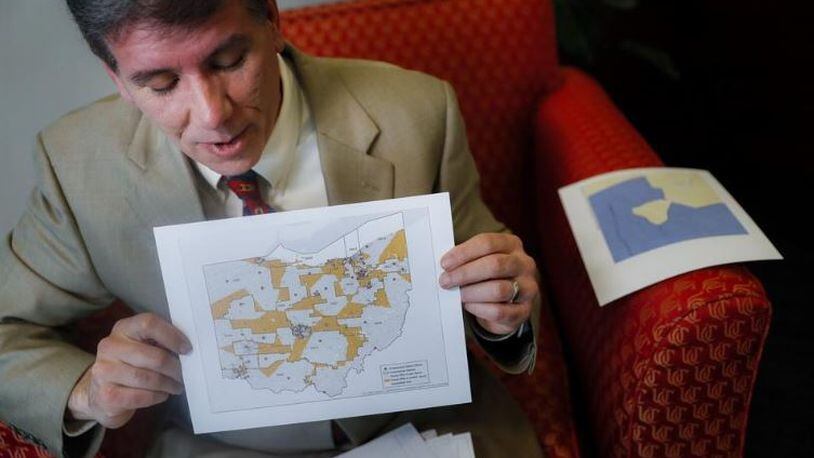In a unanimous ruling Friday by a three-judge panel, the court assailed the 16 congressional districts drawn by Republicans in 2011 amounted to “partisan discrimination” against Democratic voters across the state and led to GOP candidates holding 12 of the seats.
» RELATED: Three local Air Force vets to be honored in Columbus today
Employing sharp language, the judges denounced the Republican congressional map, ruling it was “littered with oddly-shaped districts,” adding that “the irregularity of the boundaries is further evidence that the districts’ boundaries were drawn with a predominantly partisan intent.”
“We are convinced by the evidence that this partisan gerrymander was intentional and effective and that no legitimate justification accounts for its extremity,” the judges wrote. “Performing our analysis district by district, we conclude that the 2012 map dilutes the votes of Democratic voters by packing and cracking them into districts that are so skewed toward one party that the electoral outcome is predetermined.”
» RELATED:Upcoming drone research could bring new jobs to the region
The 301-page ruling was a stunning defeat for Ohio Republicans who control all the statewide offices and both houses of the legislature. Although the decision likely will be appealed to the U.S. Supreme Court, Ohio Republicans could be forced to compete next year with districts less favorable to their candidates.
The decision likely would only impact next year’s elections because last year Ohio voters overwhelmingly approved a measure that would overhaul the state’s redistricting process after the 2020 census, requiring any new maps to have three-fifths support in the state House and Senate, including support from at least half the members of the minority party.
Under that measure, if Republicans and Democrats in the legislature cannot agree on a map, a seven-member bipartisan commission would be tasked with drawing new maps.
Those maps would require at least two votes from each party in order to pass. And if the commission can’t reach an agreement, the legislature could impose a map without minority party support, but that map would only be good for four years, rather than 10.
Ohio Attorney General Dave Yost was unhappy with the court ruling.
“Ohioans already voted to reform how we draw our congressional maps,” he said. “This protracted opinion takes that decision out of the hands of the people and is a fundamentally political act that has no basis whatsoever in the Constitution. Ohio will seek a stay of this decision and appeal it.”
The panel included federal appeals Judge Karen Nelson, nominated to the bench by former Democratic President Bill Clinton. It also included U.S. District Judge Timothy Black, named by former Democratic President Barack Obama, and U.S. District Judge Michael Watson, an appointee of former Republican President George W. Bush.
The plan, backed in 2011 by former U.S. House Speaker John Boehner, R-West Chester Twp., and signed by former Gov. John Kasich, had been widely criticized as one of the most glaring examples of what is known as gerrymandering.
Gerrymandering, which has been part of the American elections since the dawn of the Republic, is employed by a major party to design districts favorable to their own candidates.
In a sign of their impatience, the judges ordered Gov. Mike DeWine and the legislature to design their “own remedial plan” to change the districts no later than June 14 and curtly informed state officials “no continuances will be granted.”
The judges warned that if the Ohio government “fails in its task to enact a remedial plan, we have our ‘own duty to cure illegally gerrymandered districts through an orderly process in advance of elections,’ such as naming a special master to design new districts.
The decision was hailed by the American Civil Liberties Union and Common Cause of Ohio. Catherine Turcer, executive director of Common Cause of Ohio, called the ruling “a victory for Ohio voters.
“We hope the U.S. Supreme Court will uphold today’s decision in this case, along with a series of other decisions in lawsuits challenging partisan gerrymandering across the country,” Turcer said.
Ohio Secretary of State Frank LaRose said voters “overwhelmingly approved our bipartisan effort to create a better process to draw congressional districts following the 2020 census.
“Make no mistake, our office will work with county boards of elections to administer fair, accurate and secure elections in 2020, pending the conclusion of the judicial process,” LaRose said.
